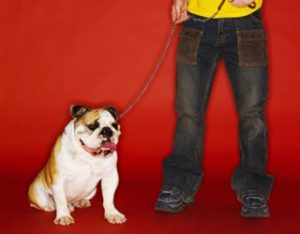Nothing in Life is Free
 In a dog’s world being the leader is not that comfortable a position. Leaders among canines and wolves carry a massive responsibility on their furry shoulders. They must be able to locate food, water, homes, settle conflicts within their family and protect their pack members.
In a dog’s world being the leader is not that comfortable a position. Leaders among canines and wolves carry a massive responsibility on their furry shoulders. They must be able to locate food, water, homes, settle conflicts within their family and protect their pack members.
The term “leader” is often misunderstood. The key to being a great leader in your dog’s eyes lies in changing the way your dog feels about your leadership capabilities. Coercion, force and punishment are signs of a weak leader. And you want to be seen as a strong leader. The great news is that it is pretty simple to be a strong leader in your dog’s eyes.
Remember that every time you interact with your dog they are learning something. Whether it is something positive or negative is up to you.
The NILIF Method (Nothing in Life is Free)
The concept of nothing in life is free changes they way that you and your dog relate to each other. This process can help a shy dog feel more secure by helping them trust you to be a stable leader, and it can also help a dog with a more dominate nature to understand their place in your home. The added benefit in this type of training is that it builds a stronger bond between you and your dog.
NILIF simply means that your dog must work for anything that it dog wants from you.
The core premise of the NILIF Method is that: Leaders control the resources. Resources can be a variety of different things. Anything that your dog finds rewarding can be considered a resource.
- Food and water
- Treats
- Toys
- Access to luxury accommodations such as the bed, the couch, chairs and/or your lap
- Walks
- Petting and affection
- Access to different rooms
- Rights to access of people entering the home
Here are a few simple ways to put this plan into action.
EXAMPLE #1: SPARKY NUDGES YOUR ARM OR HAND TO LET YOU KNOW THAT HE WANTS TO BE PETTED.
Sparky is telling you – his leader – that he wants something. You being the excellent leader that you are will not pet him without some behavior in return.
- You tell Sparky to sit and watch you.
- Sparky sits and watches.
- You may pet Sparky.
EXAMPLE #2: TIME FOR DINNER
Food is a strong motivator for many dogs. Many know exactly when it is time to eat and won’t hesitate to let you know if you’re running behind schedule. They’ll also ravenously attack their food bowls even thought they know that food will be provided again soon. This is a great time to assert your leadership position.
- Prepare Sparky’s bowl
- If Sparky is in the room, he must wait quietly while you fill the bowl
- If he jumps at you or tries to take the bowl, just stop
- Tell Sparky to sit and wait.
- Try again.
- If he persists in trying to take the bowl, leave the room
- Come back start again
- Take Sparky to his feeding place
- Have him sit
- Place bowl in his spot
- Tell Sparky to take it
You have now controlled access to your pups food and this is a valuable resource. Since you have given it to him it elevates you in your dogs eyes. Other food leadership lessons include:
- Occasionally reaching down to pet your dog while it is eating.
- If your dog is comfortable with this process then move his bowl a little bit.
- After a few days actually pick up your dogs bowl while he is eating.
- If Sparky exhibits guarding behaviors start by placing his dish on the floor.
- Sit in a chair and drop food a few pieces at a time into his bowl
- If he objects walk away for a few minutes and try again
Do not torment your dog picking up and removing the bowl over and over during his meal. A leader tells his pack when to eat but then does not annoy them while they are eating. Tormenting your pet while he is eating could potentially lead to food guarding issues.
EXAMPLE #3: SPARKY GOES TO THE TOY CABINET AND BARKS AT THE DOOR THEN LOOKS AT YOU TO TRY TO ENTICE YOUR TO PLAY.
There are two different types of toys. Your toys and the dog’s toys. You decide when to play with “your” toys, and you decide when the game ends and the toys go away. Your toys usually include things like balls, Frisbees, ropes and other interactive toys. The “dog” toys can be their favorite items to drag around and chew on.
You should be allowed to play with your dogs toys and remove them from your dogs mouth with no argument from Sparky. When your dog is demanding to play with “your toys”…
- Ignore the behavior.
- When Sparky gives up on telling you that it is play time wait just a few minutes and go to the toy cabinet
- Get a toy and call Sparky to you
- Have him sit and then say “let’s play”
- End the game before your friend is ready to. This will insure that Sparky will be excited to play again.
If you use this simple technique then you are controlling two resources, toys and play. Be sure to decide when the game ends as well as when it begins.
EXAMPLE #4:SPARKY JUMPS ON BED OR COUCH WITHOUT BEING INVITED.
When your dog decides to get up on your bed or couch, he learns that this is a “right” (as opposed to a privilege). As the leader, you control high ground and the choicest spots.
There are various schools of thought on whether pets belong on the furniture. It really is a personal choice based on your preferences and circumstances. If you do decide to allow Sparky to sit on the couch or lie on the bed, you need to treat these spaces as controlled resources. You decide when your pet is allowed on the furniture or bed, and your dog should know that he must be invited to join you. He must also get off the furniture when asked. Access to special places should be limited or closely monitored if your dog shows any aggression or resistance to being asked to relinquish “higher ground”.



 Previous Post
Previous Post